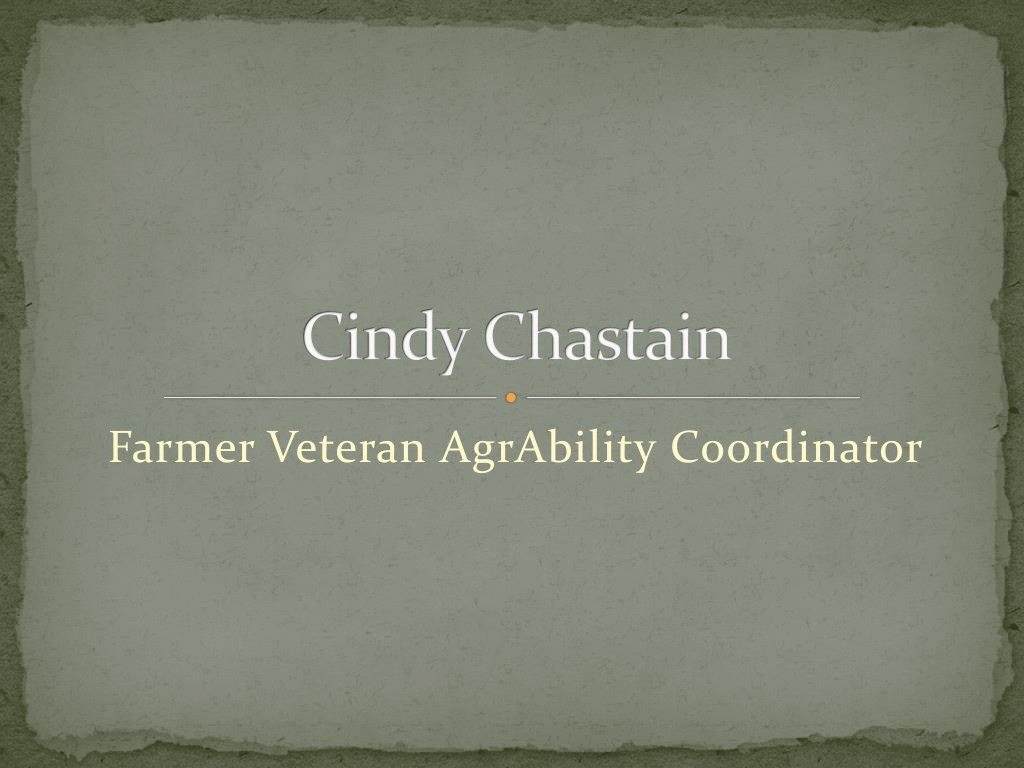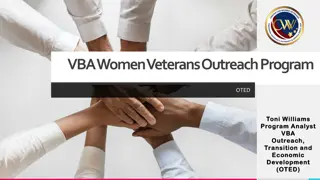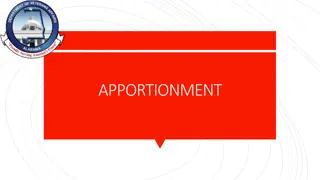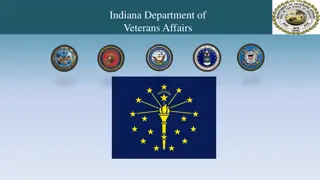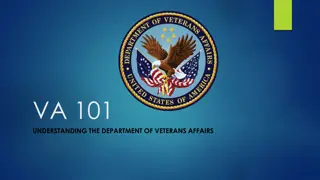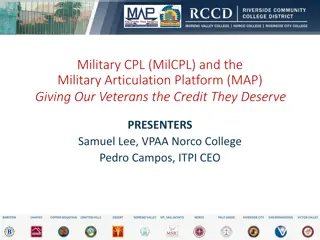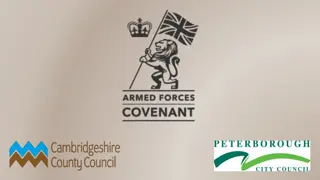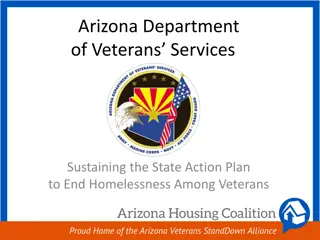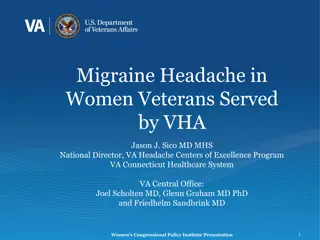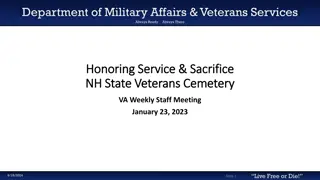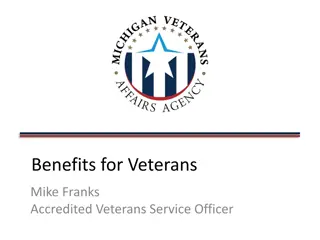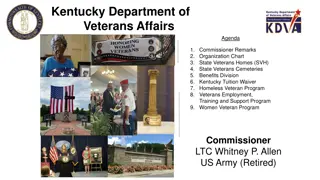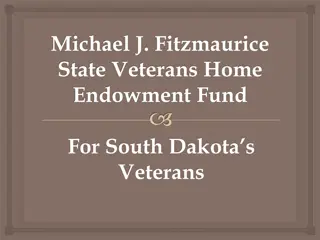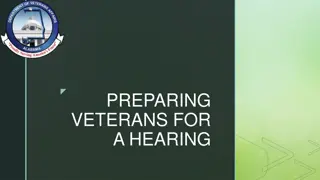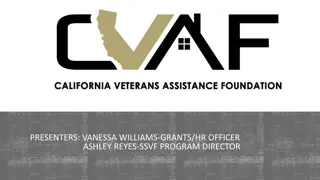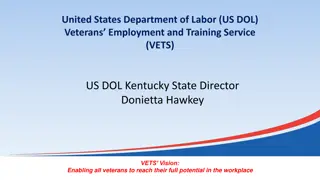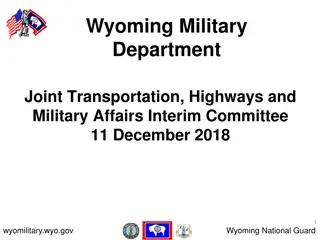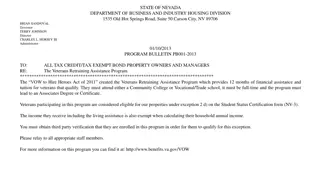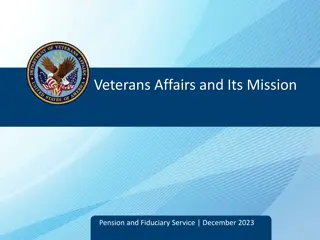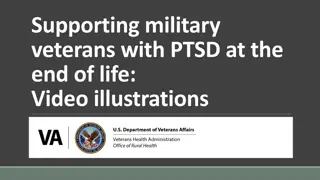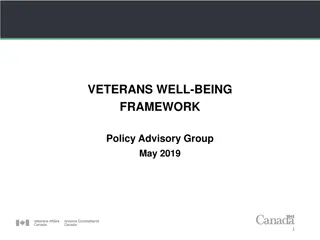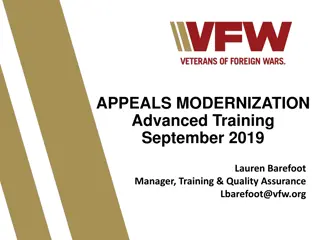Understanding Military Culture and Veterans: Insights and Strategies
Delve into the significance of military culture, the definition and commonalities of veterans, reasons for joining the service, and the structured life within the US Department of Defense. Learn about providing support and assistance to veterans to foster understanding and build relationships effectively.
Download Presentation

Please find below an Image/Link to download the presentation.
The content on the website is provided AS IS for your information and personal use only. It may not be sold, licensed, or shared on other websites without obtaining consent from the author. Download presentation by click this link. If you encounter any issues during the download, it is possible that the publisher has removed the file from their server.
E N D
Presentation Transcript
Cindy Chastain Farmer Veteran AgrAbility Coordinator
Understanding Military Culture and why is that important?
Objectives Provide an overview of the US Military, customs and culture Understanding the culture removes barriers to relationships, aids in developing rapport. Common language aids in creating alliances Do s and don ts in dealing with Veterans Most frequent disabilities of combat veterans Outreach to Veterans
What is a Veteran? Any person that served in the US Armed Forces Department of Veteran s Affairs defines those veterans eligible for VA benefits as: Discharge from active military service under other than dishonorable conditions.. Certain VA benefits require Wartime service. VA recognizes these periods of war: WWII: Dec 7, 1941 Dec 31, 1946 Korean War: Jun 27, 1950 Jan 31, 1955 Vietnam War: Aug 5, 1964 (or Feb 28, 1961 in-country veterans) May 7, 1975 Gulf War (incls Desert Storm, OIF, OEF): Aug 2, 1990 -
Commonalities of a Veteran Every soldier, sailor, airman, marine has his/her own experiences/stories Not just a job but a way of life. Duty, Honor, Country No matter how short the service, remains an important factor in their lives
Why do people join the service? All volunteer force for the past 38 years Only one in 4 Americans has a military connection Family tradition Sense of responsibility and/or service Education and training opportunities Adventure/Escape from current situation
STRUCTURE Military life is structured and regimented Chain of Command/Hierarchical Organization Right versus Wrong Doctrine and Regulations Off-Duty as well as On-Duty What Happens when that structured life goes away?
US Department of Defense Seven Uniformed branches Approx 3 million total service members Civilian controlled: Commander in Chief is the POTUS Secretary of Defense: Ashton Carter Mission: provide military forces needed to deter war and protect the security of the country
US Army Mission: fight and win our nation s wars with sustained land dominance across a full-range of military operations The largest and oldest branch of service Established as the Continental Army in 1775 to fight the Revolutionary War Active Duty (540K): 49% of the total Army strength, primarily combat and combat support units Army National Guard (360K): 33% of the total Army strength, primarily combat and combat support units Army Reserves: (205K): 18% of the total Army strength, primarily combat support and combat service support units
US Navy Mission: Power projection, strategic deliverance and tactical delivery of combat power The U.S. Navy is descended from the Continental Navy which was formed in 1775 along with the U.S. Army. However, the Continental Navy was disbanded at the conclusion of the Revolutionary War and didn't reformed until 1797 to combat Barbary Coast pirates. Active duty (317K): 83% of the total Naval strength Reserves (62K): 16% of the total Naval strength Untraditional roles in the Global War on Terror
US Air Force Mission: to provide strategic air lift and tactical air combat support The U.S. Air Force is the newest branch of the U.S. military; formed in 1947. Prior to 1947, the Air Force was considered a part of the U.S. Army Active duty (333K): 65% of the total AF strength Air National Guard (105.7K): 21% of the total AF strength Air Force Reserve (71K): 14 of total AF strength
US Marine Corps Mission: Rapid deployment force; seizure of or defense of advanced naval bases for land operations The U.S. Marine Corps was established in 1775 when two battalions of Continental Marines were formed as naval infantry. Since then, the U.S. Marine Corps works alongside the U.S. Navy to project power from the sea. The Marine Corps is the smallest of the U.S. military branches and has participated in every U.S. conflict. Active duty (195K): 83% of total USMC strength Reserves (39K): 17% of total USMC strength Shorter but more frequent deployments
Other Branches US Coast Guard (Active: 42K, Reserve 9K) Operates under the Department of Homeland Security Can be transferred to the Navy during war US Public Health Service Commissioned Corps (6K) National Oceanic and Atmospheric Administration Commissioned Corps (300)
Military Operations Global War on Terror (GWOT) War in Afghanistan/Operation Enduring Freedom (OEF) 2001-present Iraq War/Operation Iraqi Freedom (OIF) 2003-20010 Operation New Dawn in 2010 War against ISIL (Islamic State Militants) in Syria and Iraq Operation Inherent Resolve Korea Horn of Africa Homeland Defense
Core Values Army: Loyalty, Duty, Respect, Selfless Service, Honor, Integrity, Personal Courage Navy and Marine Corps: Honor, Courage, Commitment Air Force: Integrity, Service before Self, Excellence Coast Guard: Honor, Respect, Devotion to Duty
Military Structure Rank Officer (Commissioned): Overall management, planning and leadership; must have a bachelor s degree Pay grades O-1 thru O-10 Enlisted: the specialists of the military, the ones that carry out most missions Pay Grades E-1 thru E-9 Non-commissioned Officers (NCO): Enlisted members that hold a position of authority and leadership Pay grades E-5 thru E-9 Warrant Officer: Highly trained specialists Pay grades W1 thru W5 Specialty: MOS, AFSC, Ratings
Status Active Duty: Full-time military National Guard: Part-time. Minimum of 38 days/year. Full-time force, Active Guard Reserve (AGR) Dual mission; federal and state mission Army and Air Force only Reserves: Part-time Full-time AGR
Branch of Service Differences Individual service cultures rivalries Uniforms Rank/Insignia Army, Air Force, Marines versus Navy
Example of Service Differences Recruit Training Marines: Rise at 0500, train until 2000 Army: Rise at 0600, train until 1900 Navy: Rise at 0900, train until 1100, lunch until 1300, train until 1600 Air Force: Rise at 1000, breakfast in bed, lunch at 1200, nap at 1400, training ceases at 1500
Differences between conflicts WWII Dying at a rate of 670/day Reunions are rare now but have had many years to share experiences with comrades Vietnam Korea Very unpopular wars Those who served, vilified and treated poorly High incidence of alcoholism, homelessness, undiagnosed PTSD Gulf War Veterans: Desert Storm, OIF, OEF Less lethal, survival rate with severe injuries is higher Welcomed home and treated like heroes Mental health issues, while just as bad, do not carry the stigma of previous conflicts
Positives of Military Service Leadership skills, especially under duress Maturity and focus Confidence Unit cohesion and Camaraderie
Demographics (active duty) 15% female 25% minorities 92.5% with High School diplomas or higher 89.3% with bachelor s degrees or higher Average age is 25-30
How to talk to a Veteran Thank them for their service Listen non-judgmentally Ask open-ended questions about their service and symptoms/disabilities, issues Be aware of the veterans feelings about shame, survivor s guilt, problems dealing with stress and civilian life, etc. Must follow through with offers of help Ensure their families are involved and know of services available to them also
How NOT to talk to a Veteran Don t act like you know how he/she is feeling Do not get into a discussion on your political analysis of the war Do not rush the veteran into anything (unless suicidal) Don t press for detailed accounts of traumatic events Don t tell them that they were lucky Don t make decisions for them
Combat Injuries Mortality Rates for injuries WWII Vietnam OEF/OIF 30% 24% 10% More Survivors and disabilities more survivors with long-term injuries OIF/OEF 97% of injuries caused by explosions, mostly IEDs 50% of injuries were to head and neck 20% of wounded had some degree of brain injury
Signature Injuries OEF/OIF Eye Injuries Lower extremity injuries and amputations Traumatic brain injuries Repeated/serial traumatic brain injuries
Combat Exposure Effects Increased risk for Post Traumatic Stress Disorder (PTSD) Increases with multiple deployments Increased risk for depression Increased risk for alcohol-related problems Increased exposure to injury, including TBI These problems are not mutually exclusive
What is PTSD? An anxiety disorder: Characterized by emotional instability after stressful event(s) Trauma that overwhelmed the person s usual psychological defenses Trauma created an unmanageable memory that causes ongoing emotional outbursts and depression when reminded of event
PTSD symptoms Intrusive Recollections, re-experiencing Distressing dreams Avoidant Detachment/estrangement Loss of libido and initiative Hyperarousal Sleep difficulties Irritability/anger Lack of concentration Hypervigilance
Panic Attacks Palpitations Sweating Feelings of choking Chest pain Nausea Dizziness Fear of dying/losing control
Traumatic Brain Injury Symptoms/Consequences Sensory and/or motor problems Changes in behavior (personality, concentration, memory, perception, emotional control) Decreased mental efficiency Depression Anxiety Irritability Sleeping problems Headaches Fatigue Blurred vision
PTSD and TBI Overlapping Signs and Symptoms!
Treatment Considerations PTSD Medications (antidepressants, beta blockers), perhaps long term Psychotherapy (patient, family, group, cognitive behaviour) TBI Mild, may resolve w/o treatment Rehab services Counseling for adjustment to permanent disability
Veterans Outreach County Veteran Service Officers (CVSOs) Educational Institutions Veteran Service Organization (VSOs) such as American Legion, Veterans of Foreign Wars (VFW), Disabled American Veterans (DAV), American Veterans (AMVETS) Active Duty or National Guard installations Job Fairs, especially those focusing on veterans Community Based Outpatient Clinics (CBOC) Warrior Transition Units
Veterans Outreach (cont) Veterans Health Administration (VHA) Disabled Veterans Outreach coordinators (DVOPs) Veterans Rural Health Resource Centers Farmer Veteran Coalition Senior Centers or Homeless Shelters Vocational Rehab (state and/or VA) Posters/newsletters Yellow Ribbon events Blue Star or Gold Star Mothers Other veterans Social Networking
